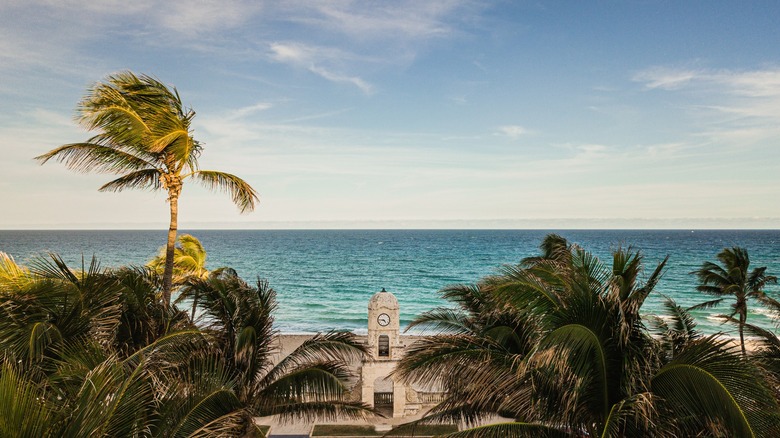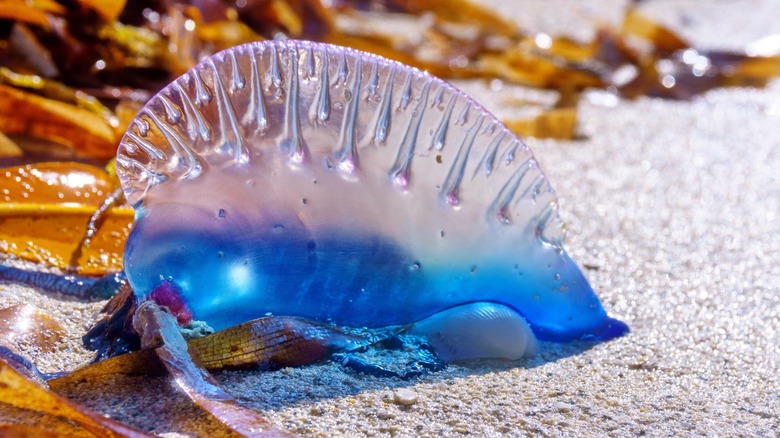The Hidden Danger That Will Make You Think Twice Before Swimming At Palm Beach, Florida
We don't like to talk about it, but the ocean isn't always a safe place. Risks surround you the moment you dip your toes into its cobalt waters, yet we frolic and play as if impervious to Mother Nature. It's time to face the reality that there are some places we shouldn't swim, including many dangerous beaches on the Florida coastline. In 2023 alone, Florida saw more shark bites than any other state, but it's actually not Jaws you have to fear off Palm Beach. Located between Port St. Lucie and Fort Lauderdale, Palm Beach has a particularly nasty hidden threat that should have you hesitating from jumping right in. The man o' war is such a problem that Palm Beach's government website lists them as a common hazard, confirming they are "predominately present during the months of November through April."
Jellyfish are a gorgeous addition to our waters, though that beauty can come with a particularly painful price. While not technically a jellyfish, the Portuguese man o' war has many of the same physical traits. The moment you see one of these siphonophores sprawled out on Palm Beach's golden sands, it's time to pack up and find a different beach altogether.
How dangerous is the Portuguese man o' war?
While sharks are a known threat in Atlantic waters, lifeguards can signal when they're too close to shore. On the other hand, the Portuguese man o' war isn't as easy to spot, especially when it's underwater. Unlike other ocean dangers like strong waves and natural predators, there's no visual indicator that a man o' war is looming nearby. Its gas-filled polyp acts like a sail and is fairly transparent, with only a thin line of color visible when on the surface.
The real hazard of the man o' war is its stinging tentacles, which can grow to over 100 feet long. Though they tend to be darker in color, they're still difficult to see in the water and may extend well beyond where the float is spotted. It's with this flowing tendril that the siphonophore does its damage, catching prey and administering a swift dose of poison via barbed tubes.
While not inherently fatal to humans, the venom can cause an allergic reaction or heart failure, though both are incredibly rare. What you do have to worry about is the pain level associated with a sting. According to National Geographic, it is agonizing, and even dead man o' war that have washed up on shore can pose a threat.
Staying out of the water in Palm Beach
If you've been justifiably turned off to swimming near Palm Beach but still plan on going, you can take solace in knowing there's plenty to do in southeast Florida. The point of the trip may be to soak in some sun, but you can also walk along the Palm Beach Lake Trail. An ecosystem rich with palms and flourishing tropical greens lines the 5.5-mile trail, cutting through neighborhoods and docks filled with lavish yachts. For a freshwater adventure, you can float down a natural lazy river at a natural Florida spring.
Speaking of greens, Palm Beach isn't short on golf courses if you want to tee off with the coastal horizon as your backdrop. Par 3 has an especially nice view as an oceanfront course, complete with a driving range, chipping area, putting green, and 39 acres of manicured grounds just feet from crashing waves. Dine at the on-site Al Fresco restaurant, which features a menu of finely crafted American-Italian fare.
Get to know the local Palm Beach history at the Flagler Museum, or immerse yourself in stunning art exhibits at the Society of the Four Arts. Break from the more serious tones for European-inspired shopping and dining at CityPlace in West Palm Beach. With its array of boutiques, casual eats, and finer cafés, this beautiful shopping district will make you forget about the man 'o war.


